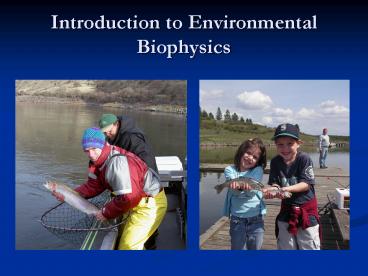Introduction to Environmental Biophysics - PowerPoint PPT Presentation
1 / 16
Title:
Introduction to Environmental Biophysics
Description:
'My desk on which I now write, and the lock of my desk, are both exposed to the ... Bare feet on a concrete floor. Convection. Heat or mass transport by fluid flow ... – PowerPoint PPT presentation
Number of Views:352
Avg rating:3.0/5.0
Title: Introduction to Environmental Biophysics
1
Introduction to Environmental Biophysics
2
Introduction to Environmental Biophysics
- Study movement of mass and energy between living
organisms and their environment
Environment
3
Environmental Biophysics
- Combination of disciplines
- Engineering and physics
- Principles to calculate movement of energy and
mass - Science
- Principles to understand fundamentals of what is
happening in systems
4
Env. Biophys. As a Discipline
- My desk on which I now write, and the lock of my
desk, are both exposed to the same temperature of
the air, and have therefore the same degree of
heat or cold yet if I lay my hand successively
on the wood and on the metal, the latter feels
much the coldest, not that it is really so, but
being a better conductor, it more readily than
the wood takes away and draws into itself the
fire that was in my skin - Benjamin Franklin, 1757
5
More from Benjamin Franklin
- Damp winds, though not colder by the
thermometer, give a more uneasy sensation of cold
than dry ones. Because, to speak like an
electrician, they conduct better that is, are
better fitted to convey the heat away from our
bodies. - Benjamin Franklin, 1753
- Source Editors. Science Milestones. Windsor
Press NY 1954.
6
Environmental Biophysicists, All
- Fundamental understanding of environmental
biophysics is basic to all of us - Required at most for our survival
- Needed at least for our comfort
- Although we did not know it, we make decisions
with this knowledge all the time - Clothes
- Environment
7
Heat and Mass Transport
- Heat and mass transport all around
- Virtually every interaction that we have
- Sight
- Reflect and emitted photons
- Photochemical reactions in the eyes
- Smell
- Fluxes of gases sensed by our olfactory sensors
- Also widely misinterpreted
- Benjamin Franklin and his desk
- Assume a temperature when things feel cold
- However, we only sense fluxes, not amounts
8
Fluxes
- Flux Quantity per unit time
- Flux density Quantity per unit time per unit
area - Fluxes consist of two parts
- Concentration difference
- Conductance
- Ability of a substance to transport heat or mass
- Our opinion of concentration (i.e. temperature)
is almost always influence by conductance
9
Our Approach
10
Principles of Energy Exchange
- Four modes of energy exchange
- Conduction
- Heat transfer by direct contact between two
bodies - Bare feet on a concrete floor
- Convection
- Heat or mass transport by fluid flow
- Wind blowing across warm soil surface
- Radiation
- Transfer of energy by photons (electromagnetic
energy) - Sun shining on plant leaf
- Latent Heat Flux
- Movement of heat by water changing states (liquid
to vapor) (2450 kJ/kg-1) - Person sweating while exercising
11
Conservation of Energy and Mass
- Basic What goes in must go out or be stored in
the system - Ein Eout- EStored
- Neither energy or mass can be created or
destroyed by any ordinary means
Energy Input
Energy Stored
Energy Output
12
Ecosystem Energy Balance
Rn - Radiation
lE - Latent Heat Flux
H Sensible heat flux
M Energy Used by System (photosynthesis, ground
storage)
Energy Balance Rn M - lE H 0
13
Continuity in Mass and Energy
- Movement of energy and mass are closely tied
- Solar radiation (energy) into a system will cause
the movement of water (transpiration) and CO2
(photosynthesis) - For this class
- First consider the movement of each individually
- Then, combine together to describe the biosphere
- Mass and Energy can move from one part or scale
to another
14
Things to Consider
- Models
- Simple representations of complex phenomena
- Necessary to allow interpretation of data
- Creative application of models art of
environmental biophysics - Heterogeneity
- Systems are heterogeneous
- Much of what we will learn is where we can apply
simplifications - Albert Einstein Make everything as simple as
possible, but not simpler
15
Units
- Always use SI (Systeme International)
- Meter, kilogram, second
- Rules and exceptions
- Always remove prefixes from denominator
- 1.45 Mg/m3 not 1.45 g/cm3
- Use scientific notation
- 5.67 x 10-8 T-4 not 0.0000000567 T-4
16
Units
- Rules and exceptions (continued)
- Watch significant digits
- If question has 3 significant digits, answer
should too - Early in semester, use oC (273.15o K)
- In radiation section, switch to Kelvin temp
- Notes
- Homework and quiz questions sometimes require
assumptions - Pay attention to learn where they can be used
- Carry units through problems
- Often will help to solve problem

